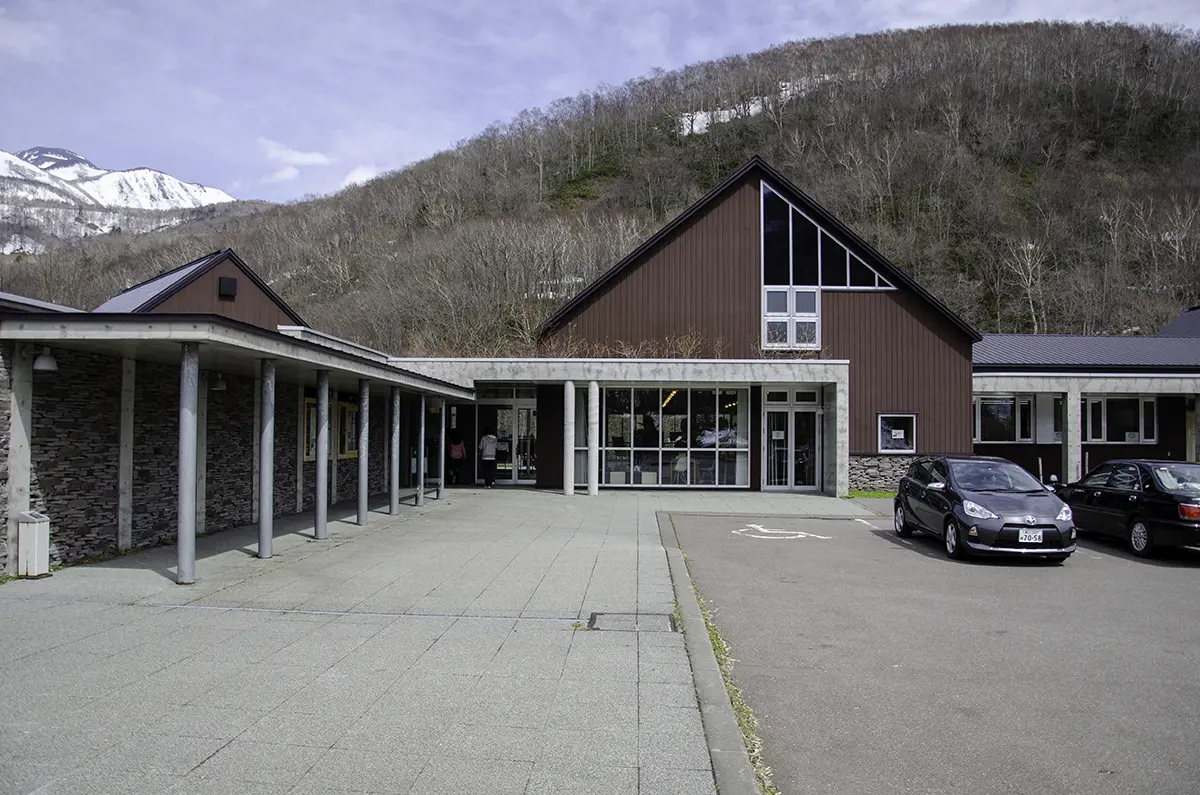Rausu Visitor Center
The Shiretoko Rausu Visitor Center is a facility established by the Ministry of the Environment as a base to connect people with nature.
It provides essential information for understanding Shiretoko National Park and enjoying its nature through exhibits, videos, and explanations about Shiretoko’s nature, history, culture, and use.
The exhibits inside the center are themed as follows:
- Formation of Shiretoko
- Shiretoko’s Ocean
- Shiretoko’s Rivers
- Shiretoko’s Mountains
- Cycle of Life
- Living in Shiretoko
Additionally, the center features an orca skeleton specimen and a map of the Shiretoko region. The video theater also shows footage about Shiretoko’s landscapes, flora, and fauna, along with etiquette for using the national park.
Opening Hours
9:00 AM – 5:00 PM (November – April: 10:00 AM – 4:00 PM)
Closed
Mondays (except July – September), New Year’s holidays
Admission
Free
Parking
4 spaces for large vehicles (buses), 30 spaces for regular cars
Other
Wheelchairs available
Rules and Etiquette
To preserve Shiretoko’s pristine nature for future generations, there are certain things you should be aware of and follow.
For your safety, please follow the instructions of nature conservation officers, forest rangers, patrol officers, and monitors.
- Do not feed wild animals: Never feed wild animals such as Ezo red foxes, brown bears, or seabirds. This not only disrupts the natural ecosystem but can also lead to brown bears approaching humans, or cause traffic accidents involving wild animals, resulting in unfortunate outcomes for both people and animals.
- Stay on marked paths: To protect vegetation, please walk only on designated footpaths and boardwalks. Even when taking photos, do not step into vegetated areas. This can damage plants and erode the soil. Especially avoid entering delicate vegetation such as wetlands and alpine plants, which are sensitive to trampling.
- Do not take, threaten, harm, or introduce plants or animals: Do not collect or harm plants, trees, or stones. This not only prevents future visitors from seeing them but also contributes to the decline of rare species. Chasing or approaching wild animals too closely threatens their lives. Observe them quietly to avoid causing stress. Also, do not intentionally introduce non-native species, as this can threaten the survival of native organisms.
- Take your trash with you: All trash should be taken with you as it can affect the scenery and wild animals. If brown bears taste juice or food remnants from discarded cans, they may start approaching humans for food and could even attack.
- Do not bring pets on mountain trails: Pets brought by humans can sometimes provoke brown bears, which is dangerous. A pet barking at a brown bear trying to pass by in the bushes can put the owner and those nearby in a dangerous situation.
- Do not eat or cook outdoors on walking trails: Spilled food or food odors can attract brown bears and foxes. Generally, do not cook anywhere other than designated campsites.
- Avoid encountering brown bears: Shiretoko is entirely brown bear habitat. Avoiding encounters is the best safety measure, so make your presence known by wearing a bell while hiking on trails. It is also important to understand brown bear ecology well and know what actions to take.
- Do not approach or provoke brown bears: This not only endangers you at the moment but also habituates bears to human proximity, which can lead to problems. Even if you spot one from your car, never get out and leave quickly.
- Drive slowly: Wild animals such as Ezo deer and foxes can suddenly jump out, leading to serious accidents. Ezo deer, in particular, tend to follow their herd. If one jumps onto the road, anticipate that others may follow.
- Do not obstruct fishing activities: Fishing is a vital industry that supports the people of Shiretoko who live in harmony with nature. Do not interfere with fishing activities by entering fishing grounds or facilities (such as kelp drying areas, fixed nets, or fishermen’s huts).
Learn More!
Shiretoko has specific rules for each area. To safely and comfortably enjoy Shiretoko’s nature, we kindly ask for your understanding and cooperation regarding the rules of use.
- Central Shiretoko Peninsula Area (primarily includes: Rausu Lake, Mount Rausu, Shiretoko Mountain Range)
- Shiretoko Peninsula Tip Area (primarily includes: Cape Shiretoko, Mount Shiretoko, Shiretoko Marsh)
- Shiretoko Five Lakes / Kamuiwakka Area Private Vehicle Regulations (primarily includes: Shiretoko Five Lakes, Kamuiwakka Hot Falls)
Access
By Car
From Kushiro, Nakashibetsu areas:
- Approx. 1.5 hours from Nakashibetsu Airport
- Approx. 3 hours from Kushiro
From Abashiri, Shari areas:
- Approx. 1.5 hours from Shari
- Approx. 2.5 hours from Memanbetsu Airport
By Bus
From Kushiro, Nakashibetsu areas:
- Approx. 1.5 hours from Nakashibetsu to Akan Bus Rausu Office
- Approx. 4 hours from Kushiro to Akan Bus Rausu Office
From Abashiri, Shari areas:
- Approx. 40 minutes from Utoro to Rausu Onsen
The closest bus stop to the Shiretoko Rausu Visitor Center is “Rausu Onsen,” about a 5-minute bus ride from Rausu town center towards Utoro.
From Rausu Onsen, walk about 10 minutes towards Shiretoko Pass; the large black building on your right will be the Shiretoko Rausu Visitor Center.

